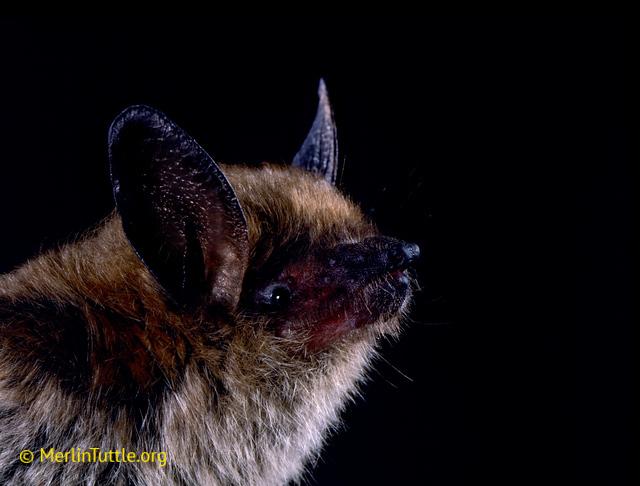Description and Range
Physical description
Fringed myotis are small bats, but one of the larger species of Myotis in Washington. Fur color ranges from yellowish brown to darker olive, with little discernible difference between the back and underparts except in Canada, where the back is pale brown and the undersides are paler. Ears and flight membranes are blackish. The outer edge of the tail membrane is lined with small stiff hairs that are visible to the naked eye, giving this species its common name. Ears are long and extend beyond the nose when pushed forward. The tragus is long and slender. The foot is large, about half the length of the tibia, and the calcar is not keeled.
Food habits and foraging
Fringed myotis feed on beetles, moths, flies, leafhoppers, lacewings, crickets, spiders, harvestmen, and other invertebrates. Presence of flightless insects in the diet indicates that some prey are gleaned from foliage. Analyses of stomach contents indicate that the main prey include moths, arachnids, leaf and plant hoppers, and beetles in western Oregon and moths and leafhoppers in eastern Oregon. The slow and highly maneuverable flight of this species is well suited to both aerial capture and gleaning of prey from foliage. This, together with the type of echolocation call, suggests that fringed myotis are adapted for foraging within forests and along forest edges. Foraging peaks one to two hours after sunset Foraging sites averaged 1.6 km from day roosts in ponderosa pine forests in Washington and Oregon.
Reproduction
Mating occurs in the fall after maternity colonies dissolve. Ovulation, fertilization, and implantation are delayed until spring. Pregnancy lasts 50-60 days and is followed by the birth of a single young pup, usually between late June and early July.
Geographic range
This species ranges across much of western North America from south-central British Columbia to southern Mexico. In Washington, fringed myotis occur primarily east of the Cascade crest. Only a few confirmed records exist for western Washington, these being from Whatcom, Thurston, and Skamania counties. Fringed myotis inhabit a variety of plant communities including desert scrub, dry grasslands, shrubsteppe, drier forest, moist coastal coniferous forest, and riparian forest, but drier woodlands (e.g., oak, pinyon-juniper, and ponderosa pine) are often preferred. Access to water sources appears to be important. This species occurs from sea level to 2,850 meters, but is most common at middle elevations from 1,200 to 2,100 meters. In ponderosa pine forest in eastern Washington, it was more common in a lower elevation watershed (760 to 1,260 meters) than a somewhat higher watershed (1,000 to 1,400 meters). Other state records come from sites with a mix of riparian vegetation, shrubsteppe, and cliffs shrubsteppe, ponderosa pine, and cliffs. Males are more common than females at higher elevations in eastern Washington.
Roosting
Day roosts, including maternity colonies, occur in trees, snags, rock crevices, caves, mines, and buildings. In regions of dry climate, fringed myotis commonly prefer rock crevices as roosts. In other parts of its range, live trees and snags are used exclusively, especially those having larger diameters and heights and in the early to moderate stages of decay with exfoliating bark present. In parts of Eastern Washington, the three largest roosts, holding 14 to 118 bats, occurred in large ponderosa pine snags.
Maternity colonies form from about mid-April to September. Those in buildings can rarely exceed 1,000 animals. In contrast, nursery colonies in trees or rock crevices are much smaller. Day roosts with one to seven females have been reported for Washington. This species is known to use torpor while day roosting. Caves, mines, rock crevices, buildings, and bridges are used as night roosts. Individuals have been reported night roosting under bridges in Whatcom County and in caves in Skamania County.
Hibernation
Hibernacula occur in caves, mines, and buildings.
Conservation
- In eastern Washington, managers should work to maintain a diversity of roost structures, including large diameter ponderosa pine snags and crevices in rocks.
- Occupation of snags is greater in forests with larger diameter trees and snags, thus the structural characteristics of the surrounding forest influence roost use and should be part of forest unit management prescriptions.
- Managers should also maintain the integrity of basalt rock outcrops and talus slopes to protect potential roosts in rock crevices.
- Proximity of day roosts to foraging and drinking sites should be considered.
- In dry environments, maintaining day roosts within 2 km of water sources (e.g., ephemeral ponds and pools along creeks) will likely benefit reproductive females.
- Riparian areas are probably important sites for foraging and drinking in low elevation westside forests and should remain protected.
- Bat surveys should be conducted in western Washington to determine abundance, distribution, and subspecific affiliation of the population there.
Preventing conflict
For some people bats don't present a problem. For others, bats can be a worry, especially when they become unwanted guests in an attic, inside a wall of a home, or inside the home itself.
Unlike rodents, bats only have small teeth for eating insects, so they do not gnaw holes in walls, shred material for nests, chew electrical wiring, or cause structural damage to buildings. Damage caused by bats is usually minimal, but they can be noisy and alarming, and the smell of bats and their droppings can be offensive. It is possible to learn to coexist with bats, and to benefit from their presence. Learn more on our Living with Wildlife: Bats webpage.
